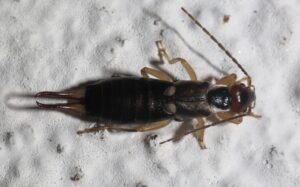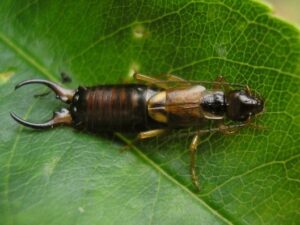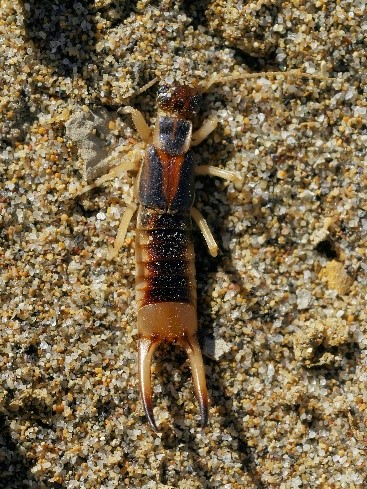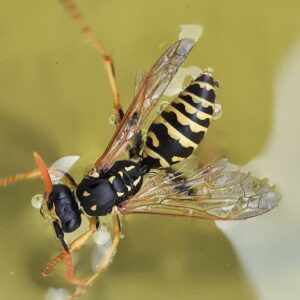Earwigs:
Striped Earwig, Riparian Earwig, or Common Brown Earwig
General Description
| · Small in size, up to 5.5 cm in length (average of 2.5 cm).
· Their color is usually black or brown, and some species in hot regions have bright colors. · The striped earwig is lighter in color than the other earwigs, and the pronotum and front wings are usually marked with pale stripes along the edges and in the middle. · At the back of the abdomen there is a forceps-like structure that earwigs use for defense and seizing prey. |

Credit: Hans Hillewaert |
Life Cycle and Common Characteristics
- The female lays 60-100 eggs and lay over top of the eggs much like a hen. They stay with the eggs for 10 days until they begin to hatch.
- The female searches for food for her young until they leave the nest themselves 2–5 days later.
- The young go on to dig their own nest for molting taking anywhere from 4 to 50 days to reach the next instar, repeating to a total of 6 instars before adulthood.
- Adults live for only 2–3 months and begin courting immediately.
- There are 2-3 generations per year, with the last generation hibernating underground through winter.
- Earwigs are nocturnal insects that hide during the day under stones and among plant leaves, or in cracks in the soil. It is also active at night and is attracted to light.
- They are propelled by three pairs of articulated legs.
- Mouth parts are biting; Therefore, the insect feeds on the garbage and live animal matter such as flies and other insects and dead animal matter. The anal pods are mutated into tweezers used to catch prey.
- This insect has the ability to develop large populations within a single season, and it can be a severe pest where land is being cleared for new buildings.
- Earwig populations often build up in areas around foundations.
- In the foundation perimeter, they are especially common at the juncture of any stone elements with the soil.
- They produce a strong odor when disturbed or crushed.
- Earwigs use these forceps to assist in predation, defense, sexual selection, mating, and wing folding.
- The striped earwig prefers dark, moist environments with a shelter that it can hide in during the daytime.
Damages and Economic & Medical Implications
- Striped Earwigs are harmfulor dangerous. These are essentially nuisance pests.
- It is considered a pest of gardens and homes.
- They are generalist predators whose diet consists entirely of insects or scavenged meat.
B – Common European earwig
General Description

Female. Credit: Luis Miguel Bugallo Sánchez |

Male. Credit: Pudding4brains |
- The European earwigs are about 1.2–1.5 cm long.
- They have elongated flattened brownish-colored bodies, with scissor-like tail.
- They have two pairs of wings and a pair of forceps-like cerci.
- The antenna consists of 11–14 segments, and the mouth parts are of the chewing type.
- Adult males are polymorphicin body weight and head width, as well as cercus length and width.
- The male forceps are robust and broadened, while the female forceps are about 3 mm long and are less robust and straighter.
- The cerci are used during, feeding mating, and self-defense.
Life Cycle and Common Characteristics
- A male finds prospective mates by olfaction (smelling).
- The mating process occurs frequently among clustered individuals.
- A single mating enable the female to lay fertilized eggs.
- The female earwig lays a clutch of about 50 eggsin an underground nest in the autumn.
- The female enters a dormant state about 5 mm below the surface of the ground and stays in the nest with the eggs.
- Adults survive in cool, moist habitats.
- They spend the daytime living on organic matter and waste found in the soil around plants and feed on some plant tissues such as flowers, fruits, and buds, insects, and the remains of dead animals.
- They appear at night in the desert, gardens, and houses near gardens.
Damages and Economic & Medical Implications
- Common European earwigs cause significant damage to crops, flowers, and fruit orchards when at high population levels.
- They are considered beneficial insects for their use in the pest management of other insects. They are natural predators of a number of other agricultural pests,
- Humans are not very fond of common earwigs because of their foul odor and annoying propensity to aggregate together in or near human dwellings.
- There is no indication in scientific sources of the toxicity of this insect and its effect on humans, except that it stings similar in effect to the pain of a bee sting.
- They may parasitize the habitats of bats and mice and may be vectors for diseases transmitted by these types of mammals.
- One of the myths and legends of Europeans is that earwigs crawl to enter the human ear and feed on the eardrum, and for this reason, it is called in some sources ear piercing or ear insect. The superstition goes that this insect only enters the ear of the elderly, and that is why it was called (the old man’s needle).



